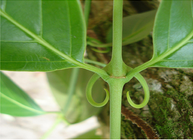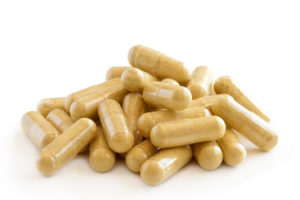Table of Contents
Cat’s Claw (Uncaria tomentosa, Uña de Gato, or Savéntaro) is a South American vine used as a nootropic with potent anti-inflammatory and antioxidant effects that support DNA repair, immune function and normal cell division.[i]
For cognitive health, Uncaria tomentosa has been used to prevent inflammation, promote cerebral circulation, fight amyloid plaques in Alzheimer’s and possibly even boost acetylcholine (ACh).
Cat’s Claw is a member of the plant family Rubiaceae, genus Uncaria that consists of at least 34 different species found in tropical forests of Southeast Asia, Africa, Central and South America.
When choosing a Cat’s Claw nootropic supplement, you need to know that at least 12 different and unrelated herbs have been marketed as Uña de Gato or Cat’s Claw.
The two South American species are Uncaria guanensis, a lower altitude shrub, and Uncaria tomentosa, a higher altitude woody vine found particularly in Peru.
The root and inner bark of the stalk of Uncaria tomentosa contains 30 known constituents including at least 17 alkaloids, along with a number of other compounds.
Researchers first thought it was the oxindole alkaloids that provided Cat’s Claw health benefits. More recently, a water soluble extract called C-Med-100® (AC-11®) was shown to possess strong antioxidant and anti-inflammatory effects.
C-Med-100® does not contain a significant amount of alkaloids. Instead the bioactive nootropic benefits of this vine are quinic acid esters.[ii]
When selecting a Cat’s Claw supplement for nootropic use, read the labels carefully. And choose only Uncaria tomentosa. We’ll have more about selecting the right supplement later in this post.
Cat’s Claw helps:
- Brain-Derived Neurotrophic Factor (BDNF). Research shows that Cat’s Claw boosts BDNF, tames NMDA activity, and repairs damaged DNA. Promoting an environment in your hippocampus for neurogenesis which is essential for learning, memory and mood. Low BDNF can lead to major depression, OCD, schizophrenia, and dementia.
- Neuroprotection. Cat’s Claw is a powerful antioxidant and anti-inflammatory. Cat’s Claw protects your brain from inflammation and damage from free radicals. Chronic inflammation has been linked to depression and dementia. Cat’s Claw also reduces the formation of plaques that are associated with Alzheimer’s Disease.
- Neurotransmitters. Cat’s Claw boosts Tryptophan levels which increases serotonin and can provide a calming effect. Cat’s Claw affects serotonin (5-HT2) receptors which helps alleviate pain.
Overview
Cat’s Claw (Uncaria tomentosa, Uña de Gato, or Savéntaro) is a large, woody South American vine that gets its name from the hook-like thorns on the leaf stem resembling the claws of a cat.

Cat’s Claw is indigenous to the Amazon rainforest and other tropical areas of South and Central America. Cat’s Claw has been used medicinally by the Aguaruna, Asháninka, Cashibo, Conibo, and Shipibo tribes of Peru for at least 2,000 years.
The Asháninka use Cat’s Claw for everything from asthma to urinary tract viral infections to cancer. I won’t go into the long list of ailments Cat’s Claw is used for here because we’re focusing on the cognitive benefits of this herb. Just rest assured, Cat’s Claw has an amazing track record.
Most of the commercially grown Cat’s Claw (Uncaria tomentosa) we get for nootropic use is from Peru. Cat’s Claw is rich in phytochemicals, alkaloids, glycosides, tannins, flavonoids, sterol fractions and other compounds.
Ignore the marketing hype of “good alkaloids”, “bad alkaloids” and “TAO-Free” for Cat’s Claw. Independent research since the early 1970’s in animals and humans have used everything from freeze-dried ground root and bark to individual extracts of specific Cat’s Claw compounds.
Cat’s Claw has been shown to decrease inflammation of arthritis[iii], prevent DNA damage[iv], reduce free radical damage[v], reduce cancer[vi], controls pain through serotonin (5-HT2) receptors[vii], and much more.
How does Cat’s Claw work in the Brain?
Cat’s Claw boosts brain health and function in several ways. But two in particular stand out.
- Cat’s Claw is a neuroprotectant. Cat’s Claw and its extracts have long been used to treat rheumatoid arthritis, asthma, chronic inflammation, immune disorders, pain, wound healing and human tumor cells.
Some of the more recent research has focused on the cognitive benefits while taking Cat’s Claw. And using Cat’s Claw to protect brain function and cognition.
One study demonstrated that an extract of Cat’s Claw could enhance DNA repair in the brain.[viii] Another study showed Cat’s Claw extract boosting Tryptophan levels which could have a profound effect on serotonin and mood.[ix] Dozens of other studies show Cat’s Claw possessing antioxidant properties, anti-inflammatory, an immune modulator, anti-tumor, antihypertensive, as well as prevention of stroke.[x]
- Cat’s Claw can increase memory and learning. Cat’s Claw extracts can help learning and memory in a healthy as well as a damaged brain.
Research shows certain alkaloid extracts of Cat’s Claw can help repair brain cells damaged by stroke or dysfunction of the acetylcholine receptors. The Cat’s Claw alkaloid Rhynchophylline is a NMDA antagonist. [xi] Selectively restricting NMDA receptors helps tone down hyperactivity and overstimulation. Providing a calm mind for clear cognition and learning.
How things go bad
Chronic stress, anxiety and free radicals (oxidation) damage your brain. This damage can manifest in several ways including memory loss, brain fog, anxiety, depression, and even neurodegenerative diseases like Alzheimer’s and Parkinson’s.
↓ Chronic stress reduces memory
↓ Free radicals kill brain cells
↓ Neuroplasticity declines degrading long-term potentiation[xii]
↓ Brain -Derived Neurotrophic Factor Declines
↑ NMDA receptors are over-active
Under conditions of chronic stress or depression caused by everyday living or chronic pain, your brain loses the capacity to transmit signals between neurons efficiently. Memory, cognition and decision-making all suffer as a result.
Cat’s Claw benefits
Research from hundreds of studies have shown that Cat’s Claw and its extracts:
- Potent antioxidant and anti-inflammatory
- Relieves pain through influence on serotonin receptors
- Enhances DNA repair
- Boosts immune health
- Suppresses tumor proliferation
- Protects against damage from stroke[xiii]
- Improve memory and cognition
- Restore the availability of acetylcholine
- Improves cerebral circulation
- Reduces stress
- Help repair brain cells
- Eliminate free radicals from within brain cells
How does Cat’s Claw feel?
Cat’s Claw is a potent anti-inflammatory and immune booster. Most neurohackers report a dramatic decrease in arthritis and joint pain.
Cat’s Claw has a reputation for reducing the symptoms of Lyme Disease and Crohn’s Disease.
Most who use Cat’s Claw regularly report they don’t get sick as often, experience less pain, and have an easier time getting to sleep and sleeping through the night.
Some neurohackers use Cat’s Claw to relieve an over-active mind. Cat’s Claw can calm racing thoughts and make it easier to focus.
Cat’s Claw Clinical Research
Cat’s Claw Improves Memory
Cat’s Claw has been reported to restore memory both in the lab and in user reviews. One method of increasing memory with Cat’s Claw may be through promoting long-term potentiation.
Rhynchophylline (Rhy) is an alkaloid isolated from Cat’s Claw that has long been recommended for treatment of diseases in the central nervous system. Researchers in China investigated using Rhy in stroke victims.
Rats were injected with Rhynchophylline once daily for 4 consecutive days before surgery, and then one more injection after surgery. The surgery created a stroke in the rats by severing a middle artery in their brain.
The team found that Rhynchophylline prevented brain damage from the stroke while increasing BDNF expression.[xiv] The Cat’s Claw extract also activated the PI3K/Akt/mTOR signaling pathway which is a necessary component of long-term potentiation.[xv]
Long-term potentiation is the strengthening of synapses between neurons which is one of the major mechanisms in the brain behind learning and memory.
Cat’s Claw Suppresses Cancer
Cat’s Claw has traditionally been used by indigenous cultures in South America and other parts of the world to treat cancer. And several studies caught my attention because I came across two Cat’s Claw customer reviews on how the herb helped them survive a dismal diagnosis of brain cancer.
Austrian researchers used Cat’s Claw extracts (isopteropodine (A1), pteropodine (A2), isomitraphylline (A3), uncarine F (A4) and mitraphylline (A5)) on human leukemia T cells on the lab.
Four of the five extracts not only stopped cancer cell growth, but killed the cancer cells outright.[xvi]
Another USA research team found that Cat’s Claw has the ability to regulate immune system cytokines that help your body’s defense against cancer.[xvii]
An Italian study investigated using Cat’s Claw extract on breast cancer. The researchers found that Cat’s Claw prevented the growth of 90% of breast cancer cells in the lab.[xviii]
A research team in Mexico found that Cat’s Claw extract stopped Wnt-signaling activity in cancer cells.[xix] The Wnt-signaling pathway is implicated in glioblastoma, the most common and most aggressive cancer that occurs in the brain.
Cat’s Claw Repairs DNA and Boosts Immune System
Researchers in Sweden used the C-MED-100 (AC-11®) extract of Cat’s Claw in rats and men.
Rats were given doses of 0, 5, 10, 20, 40 and 80 mg of the Cat’s Claw extract per kg of body weight for 8 consecutive weeks. White blood cell counts in the 40 and 80 mg treatment groups were significantly elevated over controls.
In male volunteers, healthy men were given 5 mg of Cat’s Claw extract per kg of body weight for 6 consecutive weeks. Again white blood cell count was significantly elevated in the male volunteers.
The researchers also found that DNA repair got a significant boost by Cat’s Claw extract after whole body irradiation in the rats.[xx]
A 2nd study by the same research group used C-MED-100 extract with 12 healthy men. The volunteers received either 250 mg of the extract, 350 mg of extract or a placebo daily for 8 weeks. Hydrogen peroxide was used to induce DNA damage in the men.
Both extracts provided a significant increase in DNA repair compared to the controls who received a placebo.[xxi]
Cat’s Claw Recommended Dosage
Cat’s Claw is well tolerated by most and considered non-toxic.
Cat’s Claw is available in tablets, capsules or as a water or alcohol extract tincture. Ground or freeze-dried Cat’s Claw bark can also be taken as a tea.
Cat’s Claw recommended dosage is one 100 mg capsule per day for arthritis. And one 250 or 350 mg capsule per day for cognitive and immune support.
Standardized Cat’s Claw vine or root bark extracts usually contain 3% alkaloids and 15% phenols.
Don’t mistake Uncaria tomentosa for Uncaria guianensis which is another type of Cat’s Claw from the Amazon basin. U. guianensis has a much lower alkaloid content.
Cat’s Claw Side Effects
Side effects are rare with Cat’s Claw. But may include diarrhea, dizziness or nausea.
Those with autoimmune diseases like systemic lupus erythematosus, skin grafts, tuberculosis or receiving organ transplants should not use Cat’s Claw because of its effects on the immune system. Cat’s Claw can stimulate the immune system and will counteract any medication you’re using to suppress your immune system.
Cat’s Claw is known to lower blood pressure and slow blood clotting. So if you have an issue with low blood pressure, or on high blood pressure medication you should not use Cat’s Claw.
Cat’s Claw may increase the risk of bleeding so don’t take this herb if you have a bleeding disorder, are on blood thinners, or are planning surgery.
If you are dealing with kidney disease you should avoid using Cat’s Claw.
Type of Cat’s Claw to buy
Cat’s Claw powdered inner bark of the vine is usually the least expensive form and comes in 1,000 mg capsules.
Cat’s Claw standardized extract usually contains 1.5% to 3% oxindole alkaloids and 15% phenols.
AC-11® (C-MED-100®) is a patented hot-water extract of Cat’s Claw. It’s standardized to 8% Carboxyl Alkyl Esters.
Savéntaro® POA Cat’s Claw is a standardized and patented form of Cat’s Claw with 1.3% pentacyclic oxindole alkaloids (POA) (260 mcg) and is purified to be free of tetracyclic oxindole alkaloids (TOA).
I have tried and recommend HealthyCell AC-11® or Pure Mountain Botanicals® Cat’s Claw
Nootropics Expert® Recommendation
Cat’s Claw standardized extract up to 250 – 350 mg per day
 I recommend using Cat’s Claw as a nootropic supplement.
I recommend using Cat’s Claw as a nootropic supplement.
Your body does not make Cat’s Claw. So you must take it as a supplement to get its effects.
This ancient herb has a long history of safe use as an herbal remedy in many parts of the world. Cat’s Claw (Uncaria tomentosa) is native to South America and the form referred to throughout this post.
Cat’s Claw is mostly used as an anti-inflammatory and immune system booster. Cat’s Claw is especially helpful to those dealing with the symptoms of Lyme or Crohn’s Disease. And for those dealing with arthritis, joint pain or Carpel Tunnel Syndrome.
AC-11® is often used in nootropic circles for cognitive support. Dosage of AC-11® is 350 mg per day.
Cat’s Claw can improve your mood and memory. And protect your brain from free radicals and the toxins you’re exposed to everyday.
Cat’s Claw as a nootropic has the potential to keep you mentally sharp for life. You can even out the stress and anxiety of your day by sipping Cat’s Claw tea. Or use a supplement as a cognitive enhancer.
I have tried and recommend HealthyCell AC-11® or Pure Mountain Botanicals® Cat’s Claw









Join The Discussion - 74 comments
Dahlia Din
January 18, 2020
Would Cat’s Claws help my grandchild who is 2 years old and is autistic. If so, what would be the dosage?
I am a 67 year old grandma suffering from glaucoma and my eye pressure after nightly drops of Xalatan is usually between 15-16. But yesterday to my Pleasant surprise my monthly checkup at the Opthalmologist revealed my eye-pressure had dropped to 10. Could it be due to the Cat’s Claw that I just started to consumed for the past two weeks @ 500mg x 2 capsules per day? I also found that now I have begun to have some spring in my body and moves about easier whereas before my whole body was stiff and I fear I was turning into a robot! Now I am starting to memorise verses of the Quran and I am not sure if Cat’s Claw will be helping me. I will let you know. All in all a BIG thank you to you.
David Tomen
January 18, 2020
Dahlia, go back to the top of this Cat’s Claw review and read through the entire page. It is very likely that Cat’s Claw provided the benefits you experienced.
Will it help autism symptoms? I don’t know and have not seen any clinical evidence that it will. But I have a hunch that it could help.
The thing is it would be irresponsible of me to suggest giving it to a 2 year old child. That is something that should be discussed with a medical professional who understands natural nootropic supplements.
Dahlia Din
January 19, 2020
Thank you for your valuable prompt reply. However I will give updates of my overall health situation after consuming Cat’s Claw for the benefit of others.
Mick
November 12, 2019
Hi David I would like to try Cat’s Claw. I live in Sydney, Australia and the only Cat’s Claw I can find comes with two other powders:
Uncaria tomentosa (Cat’s Claw) bark…………….….300mg
Astragalus membranaceus (Astragalus) root……. 121mg
Echinacea purpurea (Echinacea) root…………………25mg
Is it ok to take it with two other powders, or should I order on line Cat’s Claw by itself without any other herbs?
And also on the label it says: Each capsule contains herb powders (446mg)
Direction for use:
Adults: Take 2 capsules three times daily, or as professionally prescribed.
As I see it, 2 capsules would be (892mg) all together or (600mg) of Cat’s Claw in one dose, which seems to be a huge amount. And it says to take it 3 times a day.
David what would you recommend to do in this situation?
Thank You
Mick
David Tomen
November 12, 2019
Mick, I haven’t done the research on astragalus or echinacea so you’ll need to look those up on your own for now.
But for Cat Claw, dosage in all the research I’ve seen is 350 mg per day or less. While 600 mg per day may be OK I’d be very cautious about doing it 3-times per day.
My suggestion is do a little research on the other two ingredients, and make sure the three are not contraindicated with any meds you are using. Then try their recommended dose of 2 capsules and see how you feel.
Mick
November 13, 2019
Ok David I’ll do some research on it.
Thank You for your advice
Cynthia Carter
August 16, 2019
I’m curious if I take Cat Claw at the recommended dosage of 250-350 will it also work on arthritis as well as cognitive health. Or do I have to take it at 100 to make it work on the arthritis.
David Tomen
August 17, 2019
Cynthia, the higher dosage of Cat’s Claw for cognitive benefit will certainly help arthritis symptoms according to the research.
Kirsty Engler
July 2, 2019
I would really like to supplement with Cat’s Claw. I was looking at a supplement range in Australia COYS and the Cats claw is Cat’s Claw Extract (Ranunculus ternatus Thunb.) From reading your article I’m taking this as not the same as Uncaria tomentosa? Im struggling to find information to compare the two.
Do you have any recommendations of reputable companies selling cat’s claw in Australia. I was interested in making my own stacks but happy to just take single supplement as well.
Thanks
David Tomen
July 4, 2019
Kirsty, you are correct because and it’s important. All the clinical studies I’ve seen use Uncaria tomentosa. But sorry, I’m not familiar with any of the dietary supplement suppliers or vendors in Australia.
Virginia
April 6, 2019
I took Cat’s Claw daily for one year and the most noticeable improvement was with my arthritis. I assumed it stopped working when my arthritis started coming back after a year. I went off it. Will the receptors not take it up any more? Can I go back on it at some point and, if so, how soon would that be?
David Tomen
April 7, 2019
Virginia, Cat’s Claw works by fighting inflammation and free radical damage, and repairing DNA throughout your body. Which is likely why it helped your symptoms. It does not have any associated receptors.
My experience with nootropics and other dietary supplements is that it almost always takes more than one supplement to solve a problem if it can be solved.
Now you know that this works (contrary to what the doctors and mainstream medicine and press would tell you). So I suggest you dig into the research on alleviating the symptoms of arthritis. Then try new supplements in addition to Cat’s Claw. But one at a time to see if it helps.
If it does, then build yourself a “stack” of as many supplements as it takes to alleviate your symptoms. Do NOT be worried about taking too many supplements. This is not like drugs. Find and use what you need.
Diane McBride
July 20, 2018
Hello David,
I am 57 years old and have three autoimmune diseases (Graves, lupus & Reynaud’s). I am on no medications at this time and have been managing my disease through diet (AIP) and meditation (TM). While I’m mostly doing great, I am not 100% in remission and still struggle with pain (no diagnosis) and brain fog. We’re thinking about getting Cat’s Claw, but I’m concerned about its immune-boosting properties. I certainly don’t want my immune system to get a boost, but I like the idea it helps with inflammation.
Is it safe for someone with autoimmune disease to take Cat’s Claw, or is there another nootropic you would recommend?
Thanks for putting together this great website.
Diane
David Tomen
July 21, 2018
Diane, keep in mind that I’m not a doctor. So wonder why you would be concerned about preventing a boost to your immune system. In that case, Cat’s Claw is not likely the best nootropic supplement for you.
Have you considered Turmeric or Curcumin? Please study this review on Turmeric and choose a supplement that will provide the benefits you are looking for. And make sure it contains piperine so you get it’s full benefit if you try it: https://nootropicsexpert.com/turmeric/
Israa
July 9, 2018
Hi, I am 39 and diagnosed with stage 4 breast cancer. There is a relatively nontoxic chemo/hormonal therapy available but in my first cycle of chemo drug ibrance, my wbc got too low. I couldn’t take last two pills. My onc lowered the dose and today is only day 4 of my second cycle and wbc is down to 2.0 already (range 3.5-10). I’ve been taking cat’s claw in the past 2 months based on this study: https://www.ncbi.nlm.nih.gov/pmc/articles/PMC3395261/
I ‘ve been using Hawaiian Pharm nonalcoholic extract 1 mL per day. The bottle says 1 mL is equal to 300 mg dry plant. After seeing that my wbc got too low in the first cycle, I started taking it 3-4 mL a day (that’s the recommended dose on the bottle, it’s been about a week) but as I mentioned, today is only day 4 and wbc is down do 2.0 already.
I am not sure whether I should continue taking cat’s claw and if yes, how much or is there anything else I can take to help with wbc? Thank you so much for your help. We have a teenager and a toddler and things have been hard.
David Tomen
July 10, 2018
Israa, you could be using the wrong extract. Most of the studies I’ve seen are using C-MED-100 which is a unique extract of Cat’s Claw for treating DNA damage and during chemotherapy.
Andrew Wertheimer
June 28, 2018
Hi. Do you know if Cat’s Claw affects GABA? Does it up-regulate or down-regulate it? I want to take it for many important reasons but if this extrapolation holds any weight I may have to wait.
“Studies have revealed that Cat’s Claw binds to alpha-adrenoceptors, serotonin, dopamine and GABA receptors, and different phytochemical components have been demonstrated to depress motor activity and ameliorate memory disruption, indicating that Cat’s Claw is able to pass through the blood-brain barrier. By extrapolation, it would appear that Cat’s Claw has the potential to modulate pain responses within the Central Nervous System (CNS), in a similar fashion to antidepressant and anticonvulsant drugs used to modulate pain.”
Thank you.
David Tomen
June 28, 2018
Andrew, Cat’s Claw indirectly affects GABA by influencing NMDA receptors and how they function. I have not seen any research indicating that Cat’s Claw directly boosts or inhibits GABA.